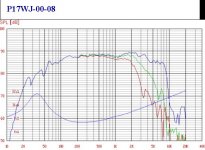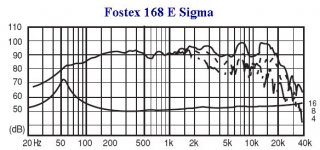Vikash said:
The first thing to know is a driver's resistance changes with frequency.
did you really mean "resistance" and not "impedance"?
if you did, are those variations considerable in the frequency range a driver can be used? i mean, not 100MHz.
Hmmm.........
Pity BF can't use his 30 years of experience to actually explain anything.
But to completely confuse a simple question which has a simple answer.
If you have a driver or loudspeaker and measure its DCR it does tell
you the driver or speakers nominal impedance assuming its not broken
or that the speaker is not badly designed - as has been stated.
Impedance meters are good for contractors in distributed PA settings,
they are part of an idiot proof methodology, and should be used here.
But note this is a DIY site, related to DIY principles and understanding.
 /sreten.
/sreten.
Pity BF can't use his 30 years of experience to actually explain anything.
But to completely confuse a simple question which has a simple answer.
If you have a driver or loudspeaker and measure its DCR it does tell
you the driver or speakers nominal impedance assuming its not broken
or that the speaker is not badly designed - as has been stated.
Impedance meters are good for contractors in distributed PA settings,
they are part of an idiot proof methodology, and should be used here.
But note this is a DIY site, related to DIY principles and understanding.
Hmmm.........
Pity BF can't use his 30 years of experience to actually explain anything.
I thought I explained it very well.
It is my assumption you may need someone to read it to you and explain in.
burnedfingers said:
It is my assumption you may need someone to read it to you and explain in.
Perhaps you ought to get someone to read this to you and explain it .....
At the risk of speaking for someone else, he meant impedance. It's just that in many of the simple formulas which govern speaker building, the impedance formulas are the same as resistance formulas, so one tends to use the simpler term.facundonu said:did you really mean "resistance" and not "impedance"?
facundonu said:if you did, are those variations considerable in the frequency range a driver can be used? i mean, not 100MHz.
In the bass range, you can count on considerable variation, whether boxed or not. Above the bass range, there can be considerable variation, although many drivers now have magnetic structures which keeps the impedance in a near resistive state throughout the range the driver is likely to be used.
Fostex is one example of a brand with such low driver inductance that it is close to resistive throughout it's usable range once you get above the bass range. There are others as well.
Here is the impedance graph from a P17WJ-00-08,
6.5 inch driver from Vifa, a well respected manufacturer. The model is now discontinued. The impedance graph is in blue, and as you can see it goes from just above 6 ohms at 300 Hz to over 16 ohms at 4,000 Hz, the highest this midwoofer is likely to be crossed over.
Most 6.5 inch midwoofs have an impedance graph that looks something like this, in fact many brands and models will have a mid and high frequency rise which is even greater.
6.5 inch driver from Vifa, a well respected manufacturer. The model is now discontinued. The impedance graph is in blue, and as you can see it goes from just above 6 ohms at 300 Hz to over 16 ohms at 4,000 Hz, the highest this midwoofer is likely to be crossed over.
Most 6.5 inch midwoofs have an impedance graph that looks something like this, in fact many brands and models will have a mid and high frequency rise which is even greater.
Attachments
Now here is the impedance graph from a Fostex 16E SigmaE. The impedance goes from 8 ohms at 300 Hz only up to 12 ohms at 20,000 Hz. Clearly, this driver is nearly completely resistive above the bass range.
The readings for both of these drivers is as if they were placed on a huge baffle, unenclosed. If placed in a box, the bass peak will be either moved up or split into two slightly smaller, but still large, bass peaks depending on the type of enclosure. (Horns are different).
As has been pointed out by Andrew T, the addition of passive crossover networks for a multi-driver system will introduce entirely new peaks and valleys in the impedance graph.
The readings for both of these drivers is as if they were placed on a huge baffle, unenclosed. If placed in a box, the bass peak will be either moved up or split into two slightly smaller, but still large, bass peaks depending on the type of enclosure. (Horns are different).
As has been pointed out by Andrew T, the addition of passive crossover networks for a multi-driver system will introduce entirely new peaks and valleys in the impedance graph.
Attachments
Hi,
tell us the Xmax of the Fostex.
I'll guess it is under 1mm, indicating a very short Voice Coil and inherently low inductance (Le).
This will lead to low mms and high efficiency and more significantly low rise in reactance at high audio frequencies. No magic, just plain sense/arithmetic.
tell us the Xmax of the Fostex.
I'll guess it is under 1mm, indicating a very short Voice Coil and inherently low inductance (Le).
This will lead to low mms and high efficiency and more significantly low rise in reactance at high audio frequencies. No magic, just plain sense/arithmetic.
AndrewT said:Hi,
tell us the Xmax of the Fostex.
I'll guess it is under 1mm, indicating a very short Voice Coil......
Hah! It's a full 1.6 mm. Nyaah nyaah. (Actually that is a very, very short Xmax, lol).
Yes, the inductance, Le, is 0.056 mH, which is about one tenth of the Vifa-and the Vifa has lower inductance than many.AndrewT said:.....and inherently low inductance (Le).
Source.
Well, the voice coil is part of the magnetic structure of the driver, after all.AndrewT said:This will lead to low mms and high efficiency and more significantly low rise in reactance at high audio frequencies. No magic, just plain sense/arithmetic.
Actually, I composed the sentence the way I did because I was going to include a bit about the shorting ring some manufacturers use. But after looking up a Peerless 6.5 incher with the shorting ring and comparing with the Vifa without the shorting ring, the impedance rise is about the same. I guess the shorting ring is there to limit distortion, not limit impedance rise. So I just deleted the part about the shorting ring and let the sentence about the magnetic structure stand.
Sorry for the misleading sentence construction.
kelticwizard said:At the risk of speaking for someone else, he meant impedance. It's just that in many of the simple formulas which govern speaker building, the impedance formulas are the same as resistance formulas, so one tends to use the simpler term.
In the bass range, you can count on considerable variation, whether boxed or not. Above the bass range, there can be considerable variation, although many drivers now have magnetic structures which keeps the impedance in a near resistive state throughout the range the driver is likely to be used.
thanks.
anyway, i thought he was talking about resistance variations with frequency, due to skin effect or something. thanks god he's just mistaken the term.
- Status
- This old topic is closed. If you want to reopen this topic, contact a moderator using the "Report Post" button.
- Home
- Loudspeakers
- Multi-Way
- simple impedance question

